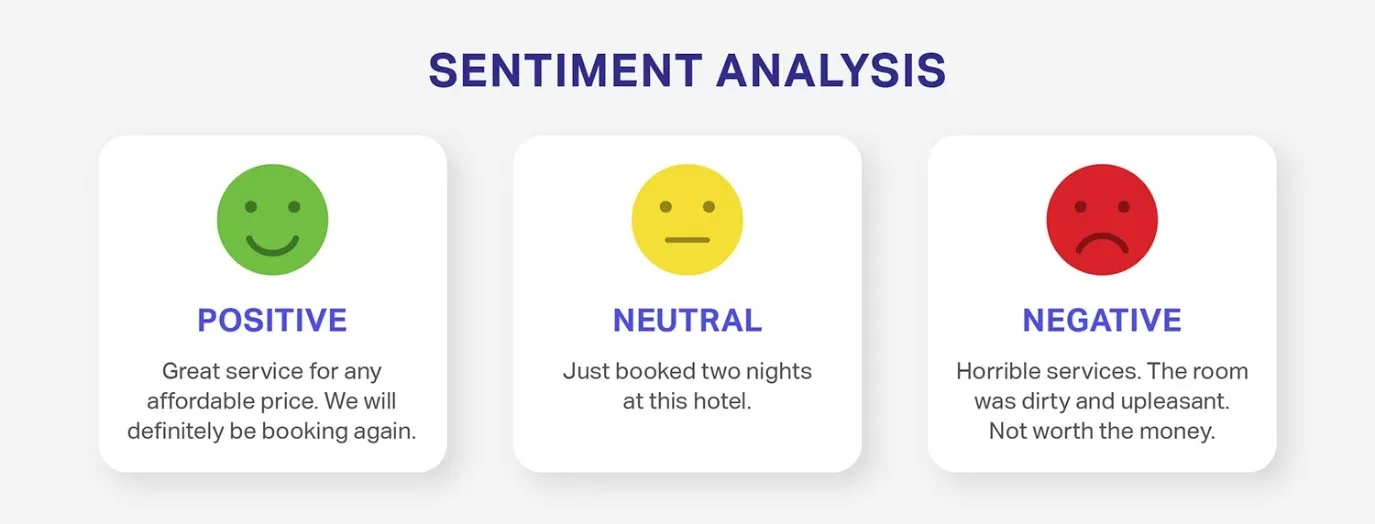With an unprecedented amount of data at our fingertips, the ability to discern the underlying emotions, opinions, and sentiments that reside within textual information is becoming increasingly important.
Sentiment analysis has emerged as a key player, providing invaluable insights to businesses, researchers, and individuals alike. While the concept itself is exciting, the true beauty of sentiment analysis comes to life when we delve into its practical implementation.
To that end, we have curated a collection of five sentiment analysis examples that illustrate its vast potential and transformative power. These case studies span diverse sectors and scenarios to prove that this technology is not just a passing trend but a cornerstone of modern data analysis.
First, let’s understand more about sentiment analysis.
What Is Sentiment Analysis?
Sentiment analysis is a field of AI that deals with identifying and interpreting sentiments in text. It uses natural language processing, text analysis, and machine learning to recognize and extract feelings from datasets. The purpose? To gauge public opinion, understand customer feedback, and analyze social media conversations.

At its core, sentiment analysis sorts emotions into positive, negative, or neutral categories. It starts with training data: a model learns from countless examples and then applies the learned patterns to new, unseen data. The process categorizes expressions into positive, negative, or neutral sentiments. For instance:
“Your website’s new design is fantastic!” → Positive sentiment
“I’m uncertain about liking the new design” → Neutral sentiment
“The new design is terrible!” → Negative sentiment
This AI technique is widely used for brand reputation analysis and customer feedback. For instance, businesses might scan social media or product reviews to understand how customers feel about their brand or products. It’s a kind of opinion mining, sifting through massive amounts of data to reveal customer expectations and reactions.
5 Examples of Sentiment Analysis
1. Customer Service Enhancement
One of the prime examples of sentiment analysis is in customer service. Companies use AI and machine learning to analyze customer interactions, such as phone conversations, emails, and social media messages.
Firms can identify negative sentiments to detect dissatisfied customers and swiftly address their concerns. On the other hand, positive sentiments are used to identify what’s working well, allowing businesses to amplify these successful elements. This technology helps to improve the overall customer experience and retention rates, turning simple interactions into valuable insights.
2. Product Analysis
Product reviews are a goldmine for sentiment analysis. The vast amount of feedback customers share on e-commerce sites, call center data, forums, and social media is a rich resource for understanding what people like or dislike about a product.
Categorizing the sentiments can help companies extract useful insights about product features, usability, pricing, and more. This analysis can guide product development, marketing strategies, and pricing decisions, ultimately driving a better product-market fit.
3. Social Media Monitoring
In our digitally-driven era, opinions are shared freely and frequently on social media. Businesses use sentiment analysis to monitor these platforms and understand how the public perceives their brand, products, or services. This brand reputation analysis is critical for businesses to manage their online image and respond promptly to potential crises.
It’s not just about damage control; positive sentiment identification can highlight brand advocates and viral marketing opportunities.
4. Market Research and Competitor Analysis
Sentiment analysis is an invaluable tool in market research. Companies can track public sentiment about industry trends and competitors by scanning online content such as blog posts, forums, and news articles. This analysis helps to understand the market landscape, identify opportunities, and shape strategic planning.
In addition, sentiment analysis can provide comparative insights – how do consumers feel about your product versus a competitor’s? Such knowledge allows companies to adjust their strategies and keep a competitive edge.
5. Brand Monitoring
Beyond social media, online conversations extend to blogs, news websites, review websites, and forums. As a critical factor influencing consumer purchase decisions, online reviews necessitate constant monitoring. Sentiment analysis serves as a powerful tool for this purpose, enabling companies to keep track of their brand reputation and gain insights about their customers’ perceptions.
Aspect-based sentiment analysis further refines this process by identifying specific product features that receive praise or criticism. For instance, if your business has released a new product or launched a marketing campaign, sentiment analysis can monitor relevant online conversations to gauge public reception and inform further strategy.
These five examples of sentiment analysis represent just a fraction of sentiment and its potential applications. As AI and machine learning technology continue to evolve, the scope of sentiment analysis will undoubtedly expand. It’ll bring new opportunities and insights across various sectors.
Training Data for Sentiment Analysis
For sentiment analysis, obtaining robust and diverse training data is crucial. The training data comprises various text samples tagged with the sentiment they express – positive, negative, or neutral. This data trains a machine learning model, enabling it to understand and categorize sentiments in unseen text data.
Sources for training data can be vast, ranging from social media comments, product reviews, customer feedback, news articles, and more. Once the model is well-trained, it can be deployed for various sentiment analysis tasks.
Several sentiment analysis services provide ready-to-use models to businesses. These services eliminate the need for in-house model development, reducing time and resource expenditures. They offer trained models capable of analyzing various types of data – from customer feedback analysis and brand reputation analysis to social media monitoring. These services empower businesses with data-driven insights, paving the way for enhanced decision-making.
Conclusion
As we’ve explored in the above examples, sentiment analysis holds remarkable potential in a variety of applications, spanning from customer service to politics. It enables organizations to unlock the power of subjective data and transform unstructured text into actionable insights.
By understanding and reacting to public sentiment, businesses can drive product development, shape marketing strategies, enhance customer experiences, and stay ahead in competitive markets. Meanwhile, in the political arena, it aids in understanding and responding to public opinion.
As AI and machine learning technology continue to advance, sentiment analysis is set to become even more pervasive and transformative.
Author Profile: Hardik Parikh
With more than 15 years of experience creating and selling innovative tech products, Hardik is an accomplished expert in the field. His current focus is building and scaling Shaip’s AI data platform, which leverages human-in-the-loop solutions to provide top-quality training datasets for AI models.




























